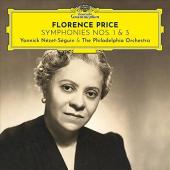Price: Symphonies 1 & 3 / Nezet-seguin
Label: DG Catalog: B003487902 Format: CD In 1933, Florence Price's Symphony No. 1 was the first symphonic work by a black woman to be performed by a major American orchestra. Infused with American folk music, spirituals and church hymns, this celebrated work reflects the experiences of a Black woman growing up in the post-Civil War South Commissioned by the Federal Music Project at the height of the Great Depression, Florence Price composed her Third Symphony amid the Chicago Renaissance, which provided a powerful setting for writers and artists such as Langston Hughes, Richard Wright, and Margaret Bonds. Price's engaging Third Symphony reflects her evolution as a composer, taking more risks, employing modern techniques, and expanding emotional elements compared to her more traditional First Symphony. The two symphonies, performed by the Philadelphia Orchestra under the baton of Yannick Nézet-Séguin, were recorded in early 2021 at Verizon Hall at the Kimmel Center for the Performing Arts in Philadelphia. Born in Little Rock, Arkansas, in 1885, Florence Price first received music lessons from her mother and later studied composition at the New England Conservatory in Boston and privately with the institute's director, George Whitefield Chadwick. After her marriage, she moved with her family to Chicago to escape the racial conflicts in the South. Soon after, she divorced her abusive husband and raised her children alone, supporting them through her work as a pianist, organist, teacher, and composer. Her Symphony No. 1 in E Major (1931-32) won the Rodman Wanamaker Contest in Composition and was premiered in 1933 by Frederick Stock and the Chicago Symphony Orchestra. Stock's encouragement encouraged Price to write more large-scale pieces. Her Symphony No. 3, written during the Great Depression as a commission from the Federal Music Project, was premiered in 1940. "In her First Symphony," Nézet-Séguin explains, "she combines folk melodies with choral writing and echoes of jazz harmony; the result sounds thoroughly American. Price took a particular form of European art music and translated it into her own idiom. In the Third Symphony, every melody sounds as if it should be sung. All the material seems vocal, the movement technique choral. I especially like that her orchestration provides solos throughout the orchestra - you get the feeling she liked all the instruments equally." Although Price composed and taught until her death in 1953, her music was almost habitually dismissed as conservative by ultramodernists. At the same time, racism and sexism kept her from finding a way into spaces where she could have succeeded. While she was noted as one of the first African American women composers to receive national recognition throughout the U.S., the performances, publications, and recordings of her music remained rare. Meanwhile, it's a different story. Price's First and Third Symphonies were published in 2008 in an impressive scholarly edition. The following year, the new owners of the composer's former summer home in St. Anne, Illinois, discovered a stack of handwritten scores that had been thought lost. By exploring Price's music, on the podium and in the studio, Yannick Nézet-Séguin and the Philadelphia Orchestra hope to help give it the place it deserves in music. The conductor puts this wish into words when he says of the Third Symphony, "If we play it and other orchestras do too, at least that's my hope, one day - perhaps in the not-too-distant future - it will become as familiar a repertoire piece and part of our orchestral life as, say, the symphonies of Tchaikovsky and Rachmaninoff."  Price: $19.98 Price: $19.98 |












